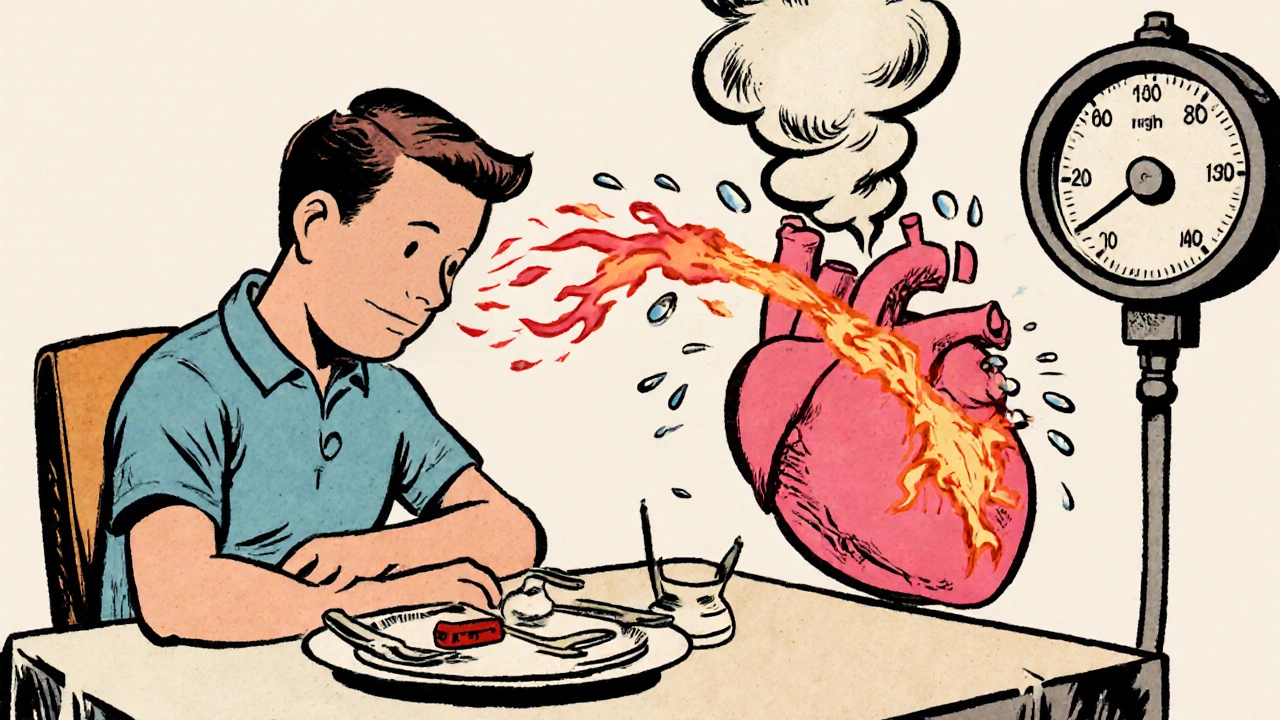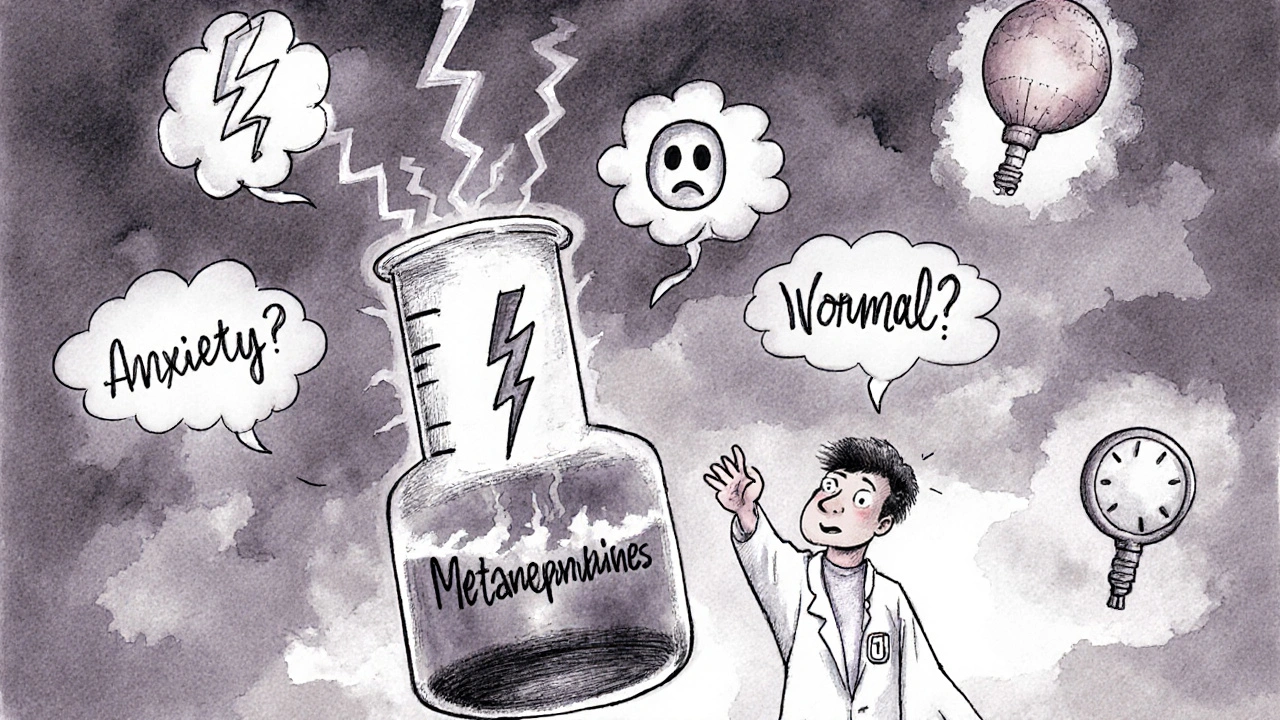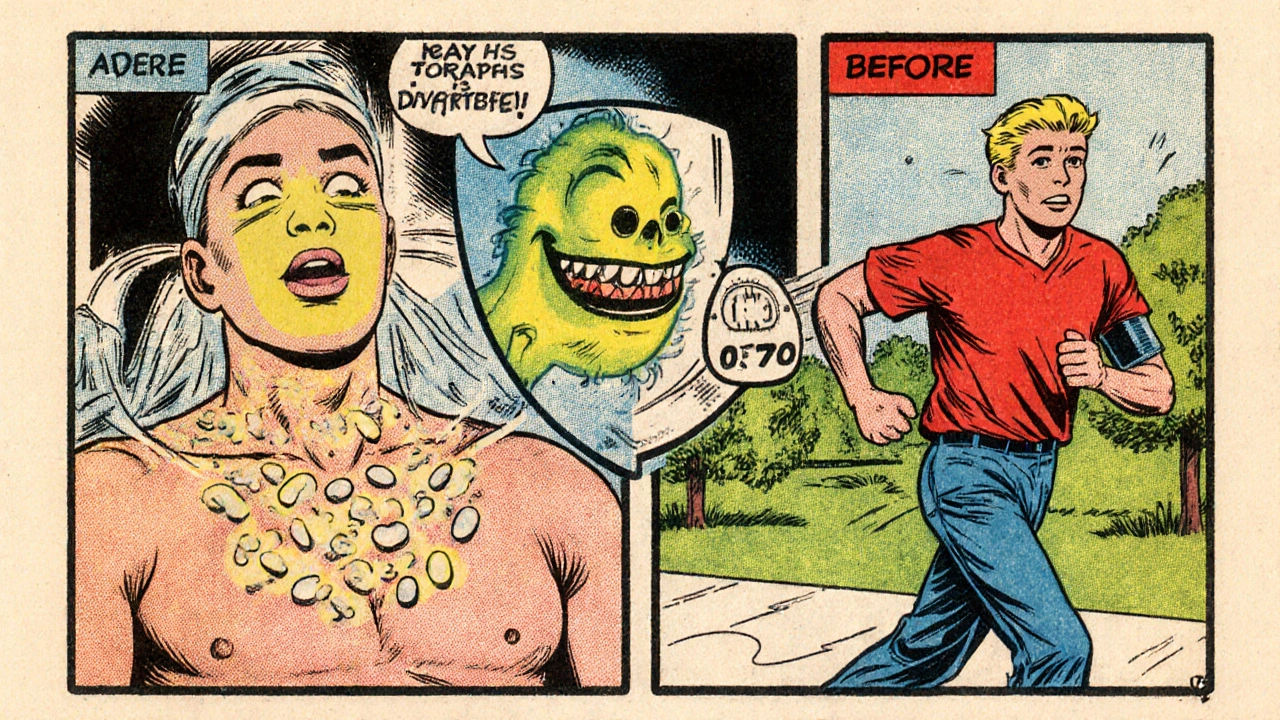Pheochromocytoma: What It Is, How It Causes High Blood Pressure, and Why Surgery Is Often the Cure
 Nov, 25 2025
Nov, 25 2025
Imagine your body’s stress response never turning off. Your heart races for no reason. You break out in cold sweat during a quiet dinner. Your blood pressure spikes so high it feels like your head might explode. For people with pheochromocytoma, this isn’t anxiety-it’s a tumor in their adrenal gland flooding their system with adrenaline, 24/7.
What Exactly Is a Pheochromocytoma?
A pheochromocytoma is a rare tumor that grows in the adrenal medulla-the inner part of the adrenal glands, which sit right on top of each kidney. These tumors don’t just sit there. They produce massive amounts of catecholamines: epinephrine (adrenaline), norepinephrine, and sometimes dopamine. These are the same chemicals your body releases when you’re scared, running from danger, or lifting a heavy weight. But with a pheochromocytoma, they’re released constantly-or in sudden, violent bursts.
It’s not cancer in most cases. About 90% of these tumors are benign. But even benign ones can be deadly if left untreated. The problem isn’t the tumor’s size-it’s the chemicals it dumps into your bloodstream. A single episode can send systolic blood pressure above 180 mmHg. That’s higher than many people see during a heart attack.
These tumors are rare. Only 0.1% to 0.6% of people with high blood pressure have one. But because the symptoms look like panic attacks, migraines, or even menopause, they’re often missed. The average person waits over three years before getting the right diagnosis. By then, they’ve seen seven doctors, been prescribed anxiety meds, and had countless tests that came back "normal."
Why Does It Cause Such Severe High Blood Pressure?
Essential hypertension-what most people mean when they say "high blood pressure"-is slow, steady, and silent. It creeps up over years. Pheochromocytoma is the opposite. It’s explosive.
The tumor triggers sudden, unpredictable surges of adrenaline. These cause:
- Sharp narrowing of blood vessels (vasoconstriction)
- Fast, pounding heartbeat (tachycardia)
- Increased force of heart contractions
That’s why patients don’t just have high blood pressure-they have paroxysmal hypertension: spikes that come and go like thunderstorms. Blood pressure might be normal one minute and 220/140 the next.
These surges are often triggered by simple things:
- Physical exertion (even walking up stairs)
- Emotional stress or fear
- Changing body position (standing up quickly)
- Urination (if the tumor is in the bladder wall)
- Even anesthesia during surgery
Some patients develop orthostatic hypotension too-when their blood pressure crashes after standing up. That’s because their body’s normal blood pressure control system gets overwhelmed by constant adrenaline surges. It’s like a car with both the gas and brake pedals jammed down at the same time.
The Classic Triad: Headache, Sweating, Palpitations
If you have a pheochromocytoma, you’re likely to experience what doctors call the "classic triad":
- Severe headaches (85-90% of cases)-often described as "the worst headache of my life," unlike migraines because they come on suddenly and are tied to adrenaline surges.
- Profuse sweating (75-80%)-not just underarms, but drenching sweats that soak clothes, even in cool rooms.
- Palpitations or racing heart (70-75%)-feeling like your heart is trying to jump out of your chest.
Other common signs include:
- Pale or ashen skin during episodes
- Abdominal or chest pain
- Nausea and vomiting
- Weight loss despite normal appetite
- Anxiety or panic attacks that don’t respond to therapy
These symptoms are so dramatic that many patients are initially sent to psychiatrists. One patient on a support forum wrote: "I was diagnosed with panic disorder for four years. Then my blood pressure hit 240/130 in the ER-and they finally ran the right test."

How Is It Diagnosed?
There’s no single test. Diagnosis starts with blood and urine tests that measure metanephrines-the breakdown products of adrenaline and norepinephrine.
Doctors use one of two tests:
- 24-hour urinary fractionated metanephrines: Sensitivity is 96-99%. You collect all your urine for a full day. The lab measures metanephrine and normetanephrine levels separately.
- Plasma-free metanephrines: A simple blood draw. Sensitivity is 97%. It’s faster but can be affected by stress, caffeine, or certain medications.
Results are considered positive if levels are more than three times the upper limit of normal. Levels between 1-3 times normal are borderline-and can lead to false positives. About 15-20% of people with borderline results end up undergoing unnecessary scans because of this.
Once biochemical testing confirms excess catecholamines, imaging follows:
- CT scan: First-line imaging. Shows the tumor’s size and location.
- MRI: Better for seeing soft tissue, especially if the tumor is near blood vessels or if the patient can’t have CT contrast.
- 68Ga-DOTATATE PET/CT: Newer, more accurate scan. Detects even small tumors and extra-adrenal cases (paragangliomas). Sensitivity is 98%, far better than old methods.
Doctors follow the "10-10-10 rule": 10% of tumors are bilateral (on both sides), 10% are outside the adrenal gland (paragangliomas), and 10% are malignant. But newer genetic studies show higher rates of multifocal tumors in people with inherited mutations.
Is It Genetic? You Need to Know
Here’s something many patients don’t realize: 35-40% of pheochromocytomas are hereditary. That means if you have one, your siblings, children, or parents might be at risk too.
Genes linked to these tumors include:
- SDHB: Highest risk of malignancy. Carriers need lifelong monitoring.
- SDHD: Often causes multiple tumors.
- VHL: Associated with kidney cancer and retinal tumors too.
- RET: Causes multiple endocrine neoplasia type 2 (MEN2).
- NF1: Neurofibromatosis type 1.
Current guidelines from the National Comprehensive Cancer Network (NCCN) say: Test everyone, no matter if they have a family history. Why? Because 25% of people with SDHB mutations have no known family history of the disease.
Genetic testing isn’t just for you-it’s for your family. If you test positive, your children have a 50% chance of inheriting the mutation. Early detection saves lives.
Surgery: The Only Cure
Unlike essential hypertension, which requires lifelong medication, pheochromocytoma can be cured-with surgery. In 85-90% of cases, removing the tumor normalizes blood pressure completely. Patients stop all their antihypertensive meds within weeks.
But surgery isn’t simple. You can’t just go in and cut out the tumor. If you do, the sudden release of adrenaline can cause a catastrophic hypertensive crisis-leading to stroke, heart attack, or death.
That’s why preoperative preparation is non-negotiable:
- Alpha-blockers: Phenoxybenzamine is the gold standard. Starts at 10 mg twice daily, increased slowly over 7-14 days. This relaxes blood vessels and prevents dangerous spikes.
- Volume expansion: Patients are put on a high-sodium diet (over 200 mEq/day) and drink 2-3 liters of water daily. The tumor causes chronic vasoconstriction, which shrinks blood volume by 20-30%. Without fluids, surgery can trigger shock.
- Beta-blockers: Only added after alpha-blockade. If given too early, they can cause unopposed alpha stimulation-making blood pressure worse.
Most surgeries today are laparoscopic-small incisions, camera-guided. Recovery is fast: 1-2 days in the hospital, back to work in two weeks. But if the tumor is large, stuck to major vessels, or if there’s bleeding, surgeons may need to switch to open surgery (5-8% of cases).

What Happens After Surgery?
Most people feel better immediately. One Reddit user wrote: "My blood pressure was 180/110 before surgery. After the tumor came out, it was 110/70 by morning. I haven’t taken a single blood pressure pill since."
But not everyone has a smooth recovery.
- Adrenal insufficiency: If both adrenal glands were removed (bilateral tumors), you’ll need lifelong steroid replacement: hydrocortisone and fludrocortisone. Without them, you can go into adrenal crisis-low blood pressure, vomiting, coma.
- Chronic fatigue: About 12% of patients report extreme tiredness lasting six months or longer. It’s not well understood, but may be linked to long-term hormonal imbalance.
- Recurrence: Even after successful removal, tumors can come back-especially in people with SDHB mutations. Annual imaging and blood tests are needed for life.
For malignant cases-where the cancer has spread-the prognosis drops sharply. Five-year survival is only about 50%. But new treatments are emerging: peptide receptor radionuclide therapy (PRRT) using 177Lu-DOTATATE has shown 65% response rates in early trials.
What If It’s Not a Tumor? Other Conditions That Mimic It
Because the symptoms are so dramatic, pheochromocytoma is often mistaken for:
- Panic disorder: The most common misdiagnosis. 42% of patients were first treated for anxiety.
- Migraines: The severe headaches can be identical.
- Carcinoid syndrome: Also causes flushing and sweating, but usually with diarrhea and wheezing.
- Mastocytosis: A rare immune disorder that releases histamine, mimicking adrenaline surges.
The key difference? Only pheochromocytoma causes massively elevated metanephrines. That’s why testing is the gatekeeper. No imaging should be done until the blood test confirms it.
What’s Next for Pheochromocytoma?
Research is moving fast. New tools are emerging:
- Belzutifan: A drug approved for VHL-related tumors. It blocks HIF-2α, a protein that helps tumors grow in low-oxygen environments. Early results show tumor shrinkage in 70% of cases.
- Liquid biopsies: Researchers are testing blood tests that detect tumor DNA. This could one day replace invasive imaging for monitoring.
- Improved genetic screening: All new patients are now tested for SDHB, even without family history. This catches hidden hereditary cases.
The Endocrine Society’s 2024 roadmap aims to standardize testing, reduce diagnostic delays, and create risk-based follow-up plans. The goal: no more three-year waits for diagnosis.
Can pheochromocytoma be cured without surgery?
No. Surgery is the only cure. Medications like alpha-blockers control symptoms and prepare you for surgery, but they don’t remove the tumor. If you don’t have surgery, the tumor will keep releasing adrenaline, raising your risk of stroke, heart attack, or sudden death. Even benign tumors can be lethal if untreated.
Is pheochromocytoma hereditary?
Yes, in 35-40% of cases. Mutations in genes like SDHB, SDHD, VHL, RET, and NF1 can be passed down. That’s why genetic testing is now recommended for every patient, even if no one in your family has had it. Some mutations carry a high risk of cancer, so knowing your status changes how often you’re monitored for life.
Can you live a normal life after surgery?
Absolutely. Most patients return to normal activities within weeks. Blood pressure normalizes, and many stop all their medications. If only one adrenal gland was removed, your body can still make enough hormones. If both were removed, you’ll need daily steroid replacement-but with proper dosing, you can live a full, active life. Fatigue may linger for months, but it usually improves.
Why do some patients need lifelong steroids after surgery?
If both adrenal glands are removed-which happens in about 10% of cases, especially with hereditary tumors-you lose your body’s ability to make cortisol and aldosterone. Without these hormones, your body can’t handle stress, regulate blood pressure, or maintain electrolyte balance. Lifelong hydrocortisone and fludrocortisone replace what your adrenals used to make. Missing a dose can lead to adrenal crisis, which is life-threatening.
What happens if pheochromocytoma is missed?
The risks are serious. Untreated, the constant adrenaline surges can cause heart muscle damage (catecholamine cardiomyopathy), stroke, heart attack, or sudden cardiac arrest. Even if you don’t have a crisis, long-term high blood pressure damages your kidneys, eyes, and brain. And if the tumor is malignant, it can spread to the liver, lungs, or bones. Early diagnosis and surgery prevent all of this.
How common is pheochromocytoma?
It’s rare. Only about 5,000 to 10,000 new cases are diagnosed each year in the U.S., out of 116 million adults with high blood pressure. That’s less than 0.1% of hypertensive patients. But because symptoms mimic anxiety and migraines, many go undiagnosed for years. Primary care doctors may see only one or two cases in their entire career.
